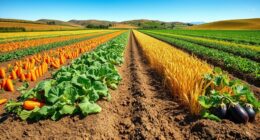Humidity control in greenhouses is essential for your plants' health and productivity. Too much humidity can lead to fungal diseases, while too little can cause wilting and nutrient deficiencies. Maintaining ideal humidity levels—around 80% during the day—ensures robust growth and minimizes stress on your crops. Effective management helps enhance photosynthesis and crop quality. Want to explore the methods and tools that can help you achieve perfect humidity levels?
Key Takeaways
- Proper humidity control prevents fungal diseases, such as powdery mildew, which can threaten plant health and productivity.
- Maintaining optimal humidity levels enhances photosynthesis, promoting robust plant growth and overall vitality.
- Effective humidity management reduces plant stress, leading to improved crop quality and increased yield.
- Consistent humidity levels facilitate efficient transpiration, ensuring better nutrient uptake and water absorption.
- Properly controlled humidity creates a healthier greenhouse environment, boosting economic viability for growers.
The Role of Humidity in Plant Health

When you consider the importance of humidity in a greenhouse, it's clear that it plays a significant role in plant health. High humidity can promote fungal diseases like powdery mildew, stressing your plants and reducing their productivity.
Conversely, low humidity causes rapid water loss, leading to wilting and browning leaves. Both extremes compromise plant health, impacting nutrient uptake and overall growth.
High humidity also slows down photosynthesis by limiting CO2 intake through stomata. To maintain vibrant, thriving plants, you need to control humidity levels effectively.
Optimal Humidity Levels for Different Crops
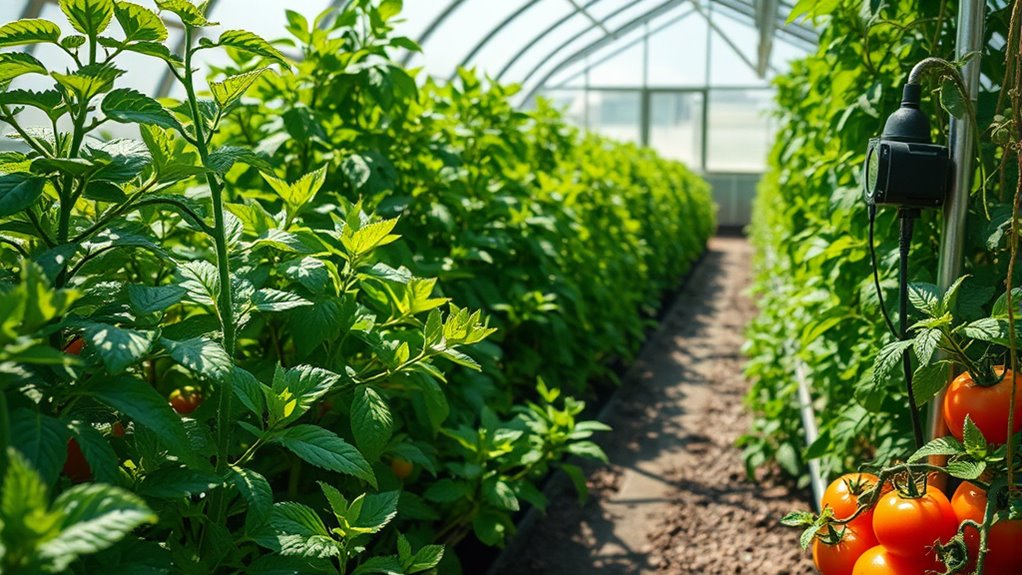
Ideal humidity levels are vital for maximizing crop health and yield in greenhouses. Most crops thrive at around 80% relative humidity during the day, while night levels can safely drop to 65-75%.
High humidity above 90% can trigger diseases like botrytis and powdery mildew, negatively impacting your plants. Each crop has unique humidity needs based on its natural habitat, so it's important to tailor conditions accordingly.
For instance, hydroponic systems require meticulous humidity management to guarantee ideal growth. Seasonal changes and external climate conditions can also influence your greenhouse's humidity levels, so staying flexible with your control systems is key.
Maintaining the right humidity not only enhances crop quality but also improves flavor, making it a significant factor in greenhouse success.
Methods for Effective Humidity Control

To effectively manage humidity in your greenhouse, you'll need to employ a combination of strategies that address ventilation, heating, cooling, and water management.
Start by using exhaust fans to remove humid air and bring in drier outside air. Implement horizontal airflow systems for better air circulation and utilize roof and side vents for passive cooling.
Utilize exhaust fans and vents to enhance air circulation and reduce humidity levels in your greenhouse.
For heating, radiant systems and heating mats can enhance air temperature, reducing condensation. Consider drip irrigation to limit evaporation and adjust your watering schedule based on plant needs.
Use humidistats to monitor levels, and automated systems can help maintain ideal conditions. Dehumidifiers and desiccants are also effective tools for managing moisture without venting outside air.
Consequences of Excessive Humidity on Plant Growth
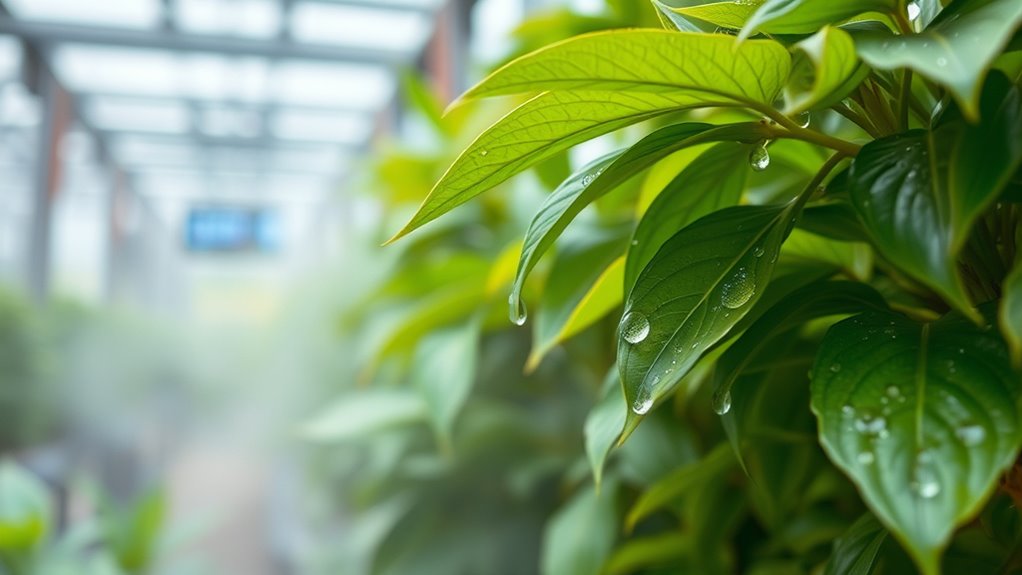
Excessive humidity in your greenhouse can severely impact plant growth, as it creates an environment ripe for various problems. High moisture levels foster the development of fungal diseases like powdery mildew and botrytis, threatening your plants' health.
Additionally, pests thrive in these humid conditions, further stressing your crops. With reduced transpiration, plants struggle to uptake essential nutrients, leading to deficiencies.
Condensation on leaves exacerbates disease issues, while soft growth increases susceptibility to root diseases. Stomatal closure limits CO2 intake, hindering photosynthesis.
Waterlogged soil reduces oxygen availability for roots, slowing growth rates. To summarize, excessive humidity can compromise crop quality and yield, making it vital to maintain balanced humidity levels for successful greenhouse gardening.
Benefits of Proper Humidity Management

When you manage humidity effectively in your greenhouse, you create an environment that fosters healthy plant growth and maximizes productivity. Proper humidity levels optimize photosynthesis, leading to robust growth and increased crop yields.
Additionally, maintaining the right humidity reduces the risk of mold, mildew, and fungal diseases, protecting your plants and cutting down on pesticide use. Consistent humidity also minimizes plant stress, resulting in better quality produce.
With improved transpiration, your plants can absorb water and nutrients more efficiently. In the end, proper humidity management not only enhances crop quality but also boosts your greenhouse's overall economic viability by reducing disease management costs and increasing the value of your harvest.
Tools and Technologies for Monitoring Humidity

Effective humidity monitoring is essential for creating the ideal environment in your greenhouse, as it directly impacts plant health and productivity.
You can use various tools like humidity sensors, which provide accurate readings of relative humidity levels. The EZO-HUM Embedded Humidity Probe offers durability and precision, while Monnit Wireless Humidity Sensors deliver temperature and dew point data with impressive accuracy.
For real-time monitoring, the Temp Stick tracks humidity levels and alerts you to critical conditions. IoT solutions enable remote monitoring through wireless sensors, and the DXM100 Wireless Controller helps you schedule events and send alerts when humidity exceeds set thresholds.
These technologies guarantee you stay informed and maintain the best humidity for your plants.
Customized Environmental Control in Greenhouses
Monitoring humidity is just one piece of the puzzle in creating an ideal greenhouse environment. Customized environmental control systems integrate temperature, humidity, CO2, and lighting to create a balanced atmosphere tailored to your crops' specific needs.
With automation, these systems enhance efficiency, reducing labor costs by maintaining suitable conditions without manual intervention. By using sensors and centralized control centers, you can adjust parameters as necessary, ensuring your plants thrive.
Plus, customization helps improve crop quality, boosts productivity, and lowers disease risks. Whether you run a large operation or a small one, these adaptable systems can scale up or down, fitting seamlessly into your existing infrastructure, ultimately leading to sustainable agricultural practices.
Energy Efficiency and Cost Savings Through Humidity Control
Controlling humidity in your greenhouse not only fosters plant health but also leads to considerable energy efficiency and cost savings.
By implementing dehumidification systems, you can reduce energy consumption by up to 24%. This efficient climate management helps maintain stable humidity and temperature, optimizing plant growth while minimizing energy waste.
You'll also notice lower operating costs, as reduced dependency on heating and ventilation cuts down expenses considerably.
Additionally, effective humidity control prevents heat loss and decreases the risk of fungal diseases, protecting your crops and boosting productivity.
Investing in dehumidification is a smart long-term choice, ensuring a healthy environment for your plants while maximizing your financial returns.
Frequently Asked Questions
How Does Humidity Affect Insect Pests in Greenhouses?
Humidity considerably impacts insect pests in your greenhouse. When humidity levels rise above 80%, pests thrive, becoming more active and reproducing rapidly. This creates ideal breeding conditions and encourages migration from outside areas.
High humidity can also weaken plant health, making them more susceptible to infestations. By managing humidity effectively, you can reduce pest populations and protect your crops, ensuring healthier plants and potentially higher yields.
Can Humidity Levels Be Too Low for Plants?
Imagine you're growing a beautiful collection of succulents, but the humidity in your space drops too low.
Yes, humidity levels can be too low for plants. It increases transpiration, leading to water loss and wilting. Your plants might close their stomata to conserve moisture, which hinders photosynthesis and stunts growth.
You could see symptoms like leaf curl or browning, making it essential to monitor and adjust humidity for your plants' health.
What Are the Signs of Improper Humidity Control?
You'll notice signs of improper humidity control when condensation forms on plants or surfaces, indicating high humidity levels.
If plants start wilting or crinkling, that's a sign of low humidity.
Water puddles on the floor or increased insect activity can also signal issues.
Additionally, if you see mold or fungus developing, your humidity management needs attention.
Keeping an eye on these signs helps guarantee your plants stay healthy and productive.
How Often Should Humidity Levels Be Checked?
You should check humidity levels at least once a day, especially during key plant growth stages like germination and flowering.
If temperatures fluctuate rapidly, increase your monitoring frequency.
Stay vigilant about your watering practices, as overwatering can raise humidity levels.
Dense plantings and seasonal changes also necessitate more frequent checks.
Using automated systems can simplify this process, providing real-time data and reducing the need for constant manual monitoring.
Are There Specific Plants That Thrive in High Humidity?
Yes, there are specific plants that thrive in high humidity.
You'll find that orchids and ferns flourish in these conditions, requiring moisture levels around 60-80%.
Bromeliads also love high humidity, showcasing vibrant foliage.
Carnivorous plants, adapted to nutrient-poor environments, thrive in similar settings.
Finally, begonias add a colorful touch and enjoy the humidity.
Conclusion
In the delicate dance of greenhouse gardening, humidity control is your trusty partner, guiding plants towards ideal health and growth. By mastering this essential element, you'll not only nurture vibrant crops but also safeguard against the lurking shadows of excess moisture. Embracing effective humidity management transforms your greenhouse into a thriving oasis, where every leaf unfurls in harmony. So, seize the tools at your disposal, and watch your garden flourish under your attentive care.


